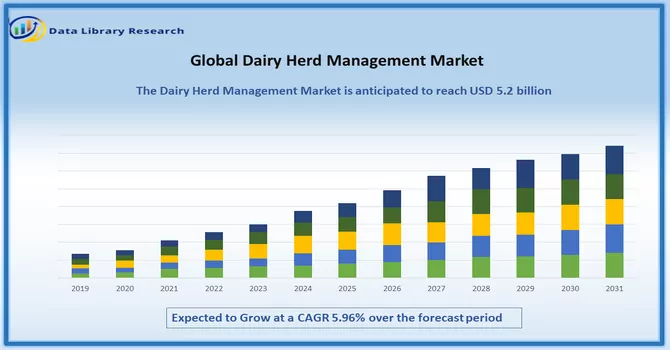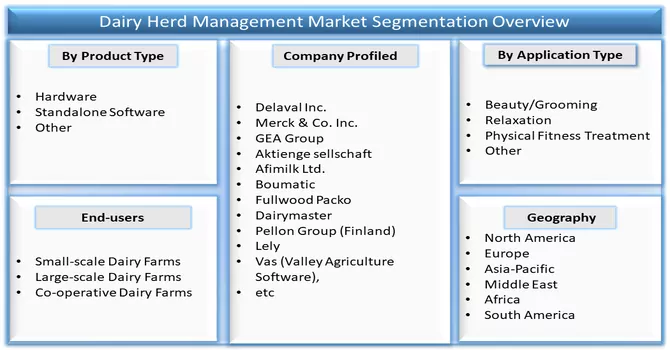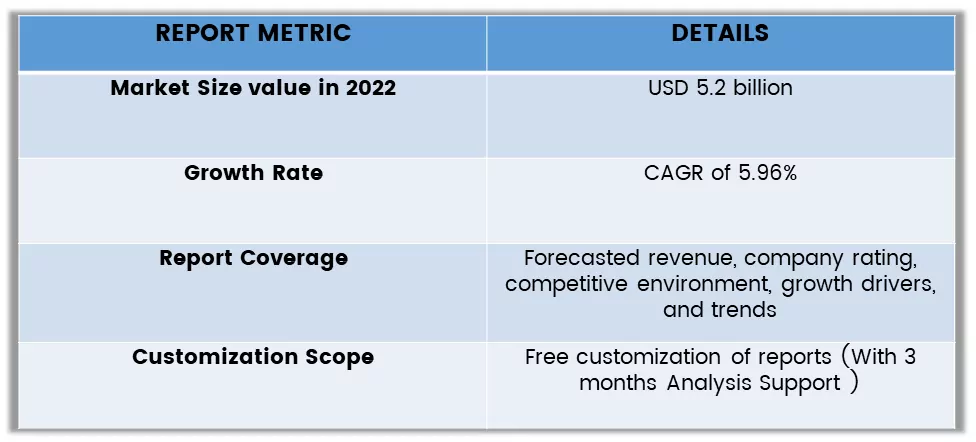The dairy herd management market is currently valued at USD 5.2 billion in 2022 and is expected to reach to a value of USD 7.8 billion by 2030, registering a CAGR of 5.96% over the forecast period.

Get Complete Analysis Of The Report - Download Free Sample PDF
Dairy herd farm management ensures that proper procedures are set up on the dairy farm to improve milk production and the cows' fertility and health. The factors driving the market include the growing herd size of dairy farms, the growth in the adoption of dairy herd management systems and software, the increasing production and consumption of milk and dairy products, and rising funding investments toward the development of dairy farms.
The long-term operational cost benefits associated with herd management solutions are expected to augment market growth. These systems assist in maintaining the health of the livestock by keeping track of feeding habits, environment control, diseases encountered, and behavior of the livestock.
By Product Type
By Application Type
By End-user Type
Geography
The report offers the value (in USD million) for the above segments.

For Detailed Market Segmentation - Download Free Sample PDF
Market Drivers:
The Growing Herd Size of Dairy Farms, Increasing Production and Consumption of Milk & And Dairy Products.
For instance, Cowherds are expected to rise at a rate of 1.2 percent per year over the next decade, according to the OECD-FAO Agricultural Outlook 2019-2028, which is greater than the forecast average yield growth (0.4 percent) and are expected to grow faster in countries with low yields. Likewise, the average dairy and suckler herd sizes for 2022 statistics published by the Department of Agriculture, Food and the Marine (DAFM), Ireland, revealed that the total number of suckler cows in Ireland on March 31, 2022, stood at 901,503 and dairy cows herds were 1,649,362. Such an increase in the dairy herd is likely to have a positive impact on market growth as this will increase the demand for dairy herd management systems among the farmers.
Furthermore, according to the article titled “Robotic milking and cattle welfare” published by Business Wales, Welsh Government, in August 2020, stated that robotic milking systems adoption has increased by 109%, 650%, 254%, 131%, and 475% in the Netherlands, Germany, Norway, Sweden, and Canada respectively from 2010 to 2018. The article further stated that nearly 10% of all dairy farms within the United Kingdom have automated milking systems. Such an increase in the adoption of dairy herd management systems is likely to augment the growth of the market over the coming years.
Similarly, the introduction of newer systems and software will augment the market growth shortly. For instance, the article published by IOP Conference Series: Earth and Environmental Science, in 2021 titled, “Automation of dairy herd management and evaluation of its economic efficiency using an information system”, summarizes how a complex system of automated herd management with the use of electronics and touch sensors allows analyzing milk samples during milking and evaluate the health status of each animal. This advanced technology saves intensive labor. Also, the use of tools such as data analytics and decision-making tools takes cattle breeding to a whole new level. These technological advancements enable efficient utilization of the individual cow’s production potential by focusing on their health, monitoring milk quality, effectively managing farms, enhancing productivity, and supervising breeding. These benefits are generating increased interest among dairy farmers toward technologically advanced herd management products and further increasing their adoption in the dairy industry.
Therefore, owing to the aforementioned factors the studied market is anticipated to witness growth over the analysis period.
Market Restraints:
The Low Awareness in Developing Countries and Higher Initial Investment
An article titled, “Understanding the Awareness, Knowledge, and Opinion of Dairy Cattle Welfare among Dairy Farmers in Keningau, Sabah” published in June 2021, reported that a questionnaire was developed, validated, and administered by hand to 30 farmers. The data collected include farmers’ and farm demographics, and opinions regarding the criteria and indicators of dairy care welfare (DCW) reported that only 17 respondents (57%) had heard of “dairy cattle welfare” before this study. Nine farmers (30.0%) had poor knowledge about DCW criteria, whereas 13 (43.7%) and 8 (26.7%) farmers had satisfactory and good knowledge, respectively. Thus, since lack of proper knowledge about dairy herd management by farmers may slow down the growth of the studied market.
Also, if the average feed cost per cattle ranges at approximately USD 5.50 per day this may be quite high for the farmers living in the developing countries, thereby slowing the growth of the studied market.
Globally, COVID-19 has impacted various markets including the dairy herd management market. The demand for dairy products reduced significantly amid the outbreak. For instance, as per the survey titled “Evaluating Impacts of COVID-19 on the Dairy Industry” published by Worcester Polytechnic Institute, in May 2020, the United States Department of Agriculture disclosed that the market value of dairy products lowered sharply as the COVID-19 pandemic extended in the United States. This was a result of demand redirecting from the food service industry to retail, largely as a result of school closures and fewer restaurant services. Furthermore, the market growth rate was also hampered by supply chain disruptions and labor shortages throughout the pandemic phase.
Since herd management is a labor-intensive procedure and the costs of labor are quite high in several developed countries, this has resulted in the uptake of numerous dairy management systems globally. For instance, as per the article titled “Care in dairy farming with automatic milking systems, identified using an Activity Theory lens” published in the Journal of Rural Studies, in October 2021, in Sweden, 34% of herds and 19% of the dairy cows in official statistics of 2021 have an automatic milking system (AMS). Thus, owing to the aforementioned factors the initial impact of the pandemic on herd management was adverse, however, with the introduction of numerous dairy herd management systems coupled with the advantages of these systems, the market is anticipated to witness substantial growth over the forecast period.
The Milk Harvesting Segment is Expected to Witness Significant Growth Over the Forecast Period.
Milk harvesting is the process of gathering or collecting milk from a female cow, buffalo, or goat for various human uses. Factors such as automated milk harvesting are leading to increasing milk production. Manual milking is often very time-consuming hence automation of auto-milking has grown significantly, which also reduced the cost and the need for manpower.
Automated milking leads to better milk production and therefore this milk can be harvested and can be used for various other requirements. For instance, the journal, Journal of Dairy 2021, titled, “Benchmarking of farms with automated milking systems in Canada and associations with milk production and quality” summarizes the use of automated miking can increase the productivity of milk by up to 12%, high milk yield can be established using electronic milk meters and cow’s daily milk needs can also determine by this system. Another benefit of automated milking is the detection of oestrus and disease, in herds Automation helps in the detection of oestrus or diseased cows by determining the detection from the normal milk yield, as a result, automation allows milk production without supervision.
The rising usage of intelligent cooling tanks to preserve milk has also driven the growth of the milk harvesting segment over the forecast period. Raw milk has a shelf life of weeks and it needs to be refrigerated before undergoing pasteurization and used to make dairy products like butter, and cheese. Dairy and milk products are rich sources of vitamins and minerals and the milk cooling tank not only increases the shelf life of the milk but also helps in easy transportation to different places. The transportation time and the distance are increased between farms, dairy, and consumers This time-lapse has resulted in an effect on the quality of milk, and thus due to this, there is the increased use of milk tanks. For instance, an article titled, “A novel solar-powered milk cooling refrigeration unit with cold thermal energy storage for the rural population” was published in the journal, Environmental Science Pollution and Research summarizes that thermal storage of milk helps to increase its shelf life for a longer duration which directly leads to increase in a global increase in milk consumption and decrease the initial cost to be reduced.
Therefore, the milk harvesting segment is expected to witness significant growth over the forecast period due to the abovementioned factors.
Standalone Software Segment is Expected to Witness High Growth over the Forecast Period.
Dairy Management Software is designed for managing dairy farms. But, with the help of technology, farmers can monitor each and every activity happening on the farms and record them automatically. Also, the software assists in driving all your efforts towards increased sales at lower costs.
Co-operative Dairy Farms is Expected to Witness High Growth Over the Forecast Period.
Dairy cooperative farms business is owned, operated, and controlled by the dairy farmers who benefit from its services. Members finance the cooperative and share in profits it earns in proportion to the volume of milk they market through the cooperative. In August 2020, Dairy Farmers of America (DFA), a national dairy cooperative owned by family farmers, announced today a continued step forward in its commitment to sustainability, as it becomes the first U.S. dairy cooperative to set a science-based target to reduce greenhouse gas (GHG) emissions. Thus, such initiatives are fueling the growth of the studied segment.
North America is Expected to Dominate the Dairy Herd Management Market.
Strategic planning toward dairy herd improvement in the United States has led North America to dominate this market. The reason the United States dominates this market is due to the certain government initiative policies that work with farmers to improve the organization, leadership, and operation of cooperatives and to give guidance to further development for dairy herd management activities. For instance, the U.S. Department of Agriculture Rural Business-Cooperative Service has come forward and collaborated with local farmers to develop cooperatives to obtain supplies and services at lower cost and to get better prices for dairy products, helping cooperatives improve services and operating efficiency, and encouraging international cooperative programs. All these policies have molded their system in a very strong way, thereby the output and increasing production of dairy products.
Also, the advancement of technologies and the coming of new software in the market that monitors the overall activity of dairy herds has led North America to dominate this market. For instance, MilkingCloud is an online platform that provides complete tools related to dairy herd management. The platform serves a wide range of services like herd management, milk management, feed management, reproductive health, and cost management. Similarly, another online platform called Fossanalytics is also providing a wide range of dairy herd management services. Such initiatives and advancements can help farmers to gather more knowledge and provide better management of herds.
Due to the above-mentioned reasons, North America is expected to dominate the dairy herd management market.

Get Complete Analysis Of The Report - Download Free Sample PDF
The dairy herd management market is consolidated in nature due to the presence of fewer companies operating globally as well as regionally. The competitive landscape includes an analysis of a few international as well as local companies that hold the market shares
Key Players :
Recent Developments:
1) In March 2021, GEA Group launched its platform- GEA Dairy Net. The following would help in analyzing and collecting data at the milking g parlors and help them achieve more efficiency. GEA has engineered this new herd and farm management system based on over 35 years of experience in the field and marks the latest evolution in the proven GEA DairyPlan system.
2) In January 2021, MSD Animal Health, a division of Merck & Co., Inc. went into a partnership with LIC Automation. The latter provides specialized and integrated herd management systems and testing sensors for livestock. LICA is a leader in automation and technology for the dairy industry which in turn will help MSD Animal Health, especially in increasing its reach.
Q1. How much is the Dairy Herd Management Market worth?
The dairy herd management market is currently valued at USD 5.2 billion in 2022 and is expected to reach to a value of USD 7.8 billion by 2030
Q2. What is the Growth Rate of the Dairy Herd Management Market?
Dairy Herd Management Market registering a CAGR of 5.96% over the forecast period.
Q3. What segments are covered in the Dairy Herd Management Market Report?
Dairy Herd Management Market Report has covered segments like - By Product Type, By Application, By End User And Geography
Q4. Which are the major companies in the Dairy Herd Management Market?
Delaval Inc., Merck & Co. Inc.,GEA Group are the few major companies of Dairy Herd Management Market
Data Library Research are conducted by industry experts who offer insight on industry structure, market segmentations technology assessment and competitive landscape (CL), and penetration, as well as on emerging trends. Their analysis is based on primary interviews (~ 80%) and secondary research (~ 20%) as well as years of professional expertise in their respective industries. Adding to this, by analysing historical trends and current market positions, our analysts predict where the market will be headed for the next five years. Furthermore, the varying trends of segment & categories geographically presented are also studied and the estimated based on the primary & secondary research.
In this particular report from the supply side Data Library Research has conducted primary surveys (interviews) with the key level executives (VP, CEO’s, Marketing Director, Business Development Manager and SOFT) of the companies that active & prominent as well as the midsized organization
FIGURE 1: DLR RESEARH PROCESS

Extensive primary research was conducted to gain a deeper insight of the market and industry performance. The analysis is based on both primary and secondary research as well as years of professional expertise in the respective industries.
In addition to analysing current and historical trends, our analysts predict where the market is headed over the next five years.
It varies by segment for these categories geographically presented in the list of market tables. Speaking about this particular report we have conducted primary surveys (interviews) with the key level executives (VP, CEO’s, Marketing Director, Business Development Manager and many more) of the major players active in the market.
Secondary ResearchSecondary research was mainly used to collect and identify information useful for the extensive, technical, market-oriented, and Friend’s study of the Global Extra Neutral Alcohol. It was also used to obtain key information about major players, market classification and segmentation according to the industry trends, geographical markets, and developments related to the market and technology perspectives. For this study, analysts have gathered information from various credible sources, such as annual reports, sec filings, journals, white papers, SOFT presentations, and company web sites.
Market Size EstimationBoth, top-down and bottom-up approaches were used to estimate and validate the size of the Global market and to estimate the size of various other dependent submarkets in the overall Extra Neutral Alcohol. The key players in the market were identified through secondary research and their market contributions in the respective geographies were determined through primary and secondary research.
Forecast Model
